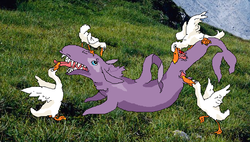Short-eared tree porpoise
The short-eared tree porpoise (Coryisynthionythustikicus malawi, synonym C. dibbabathtubulus), also referred to as a goobler, is a medium to large sized toothed whale in the mammal family. Females of the species typically measure between four and eight feet long nose to tail and may weigh upwards of five hundred pounds. Males rarely surpass three feet in length and are considerably more gracile than their mates at only 45 - 60 pounds. Unlike most other toothed whales, notably orcas and dolphins, the goobler is fairly independant from the water, getting most of what it needs from its diet. Also unusual (although not unheard of) for a toothed whale is the short-eared tree porpoise's tree-dwelling habits and it's fondness for citrus fruits, especially kumquats and tangelos.
Appearance[edit | edit source]
The short-eared tree porpoise quite closely resembles it's closest living relative, the killer whale, or a snake or a school bus, but in this species the ears have been reduced to mere nubs, rarely more than eight inches long. The animal's long, sinuous body has also adapted for an arboreal lifestyle, and thus while an aquatic porpoise has floppy fins quite inadequate for tree climbing, the short-eared tree porpoise has powerful fins with long, curved claws highly suited for tree climbing. The short-eared tree porpoise also has a series of horizontal black stripes running along its flanks, with white or rarely salamander-pink patches around its eyes. These are believed to confuse predators such as owls and allow the porpoise a speedy escape into the forest canopy.
Habitat and Behavior[edit | edit source]
The short-eared tree porpoise lives in the humid, subtropical rainforests of India and Wyoming. Here it rarely, if ever touches the ground, preferring instead to swing effortlessly from tree to tree by means of it's long, prehensile tail and muscular forehead. Females usually live in small family groups while males, highly aggressive as adults, are usually solitary but may when young travel in small bachelor herds as well, similar to cheetahs but without the stupid spots. The short-eared tree porpoise lives in tree hollows abandoned by other animals, usually the pileated woodpecker, where it makes an intricate nest out of twigs, mud and baby orangutan skin, which is stripped carefully from the baby orangutan as it sleeps. The animal is also primarily nocturnal, rarely leaving it's urine-saturated home during the day, unless it has pups to feed.
The short-eared tree porpoise is very well adapted for a rainforest life. Not only does it have a prehensile tail and sharply clawed flippers but also a greatly enlarged dorsal fin that allows the porpoise to glide gracefully for up to three feet in ideal conditions. The porpoise also has exceptional eyesight and phenomenal hearing, allowing it to spot a predatory fox over eleven miles away and hear it breathe from over 25 miles away. However, the short-eared tree porpoise is particularly lacking as far as its sense of smell, and thus it's main predators can be as odorous as they wish without risking losing a meal.
The short-eared tree porpoise, like some other whales, is a very capable swimmer. Nevertheless, the animal is very hydrophobic and will enter the water only when absolutely necessary, such as when pursued by a dingo. Despite its swimming abilities, if the porpoise finds itself in water more than 2 - 3 inches (some centimeters) in depth, it will certainly drown.
Unlike virtually all other cetaceans, tree porpoises cannot echolocate. However, it is thought they can predict the future, at least to an extent (see below).
Diet[edit | edit source]
Predominately herbivorous, the short-eared tree porpoise has a very specialized niche and as such it has a very specific diet. Over 80% of the porpoise's calories come from grains that grow in open meadows, mostly oats but also wheat and rice. It also eats a large amount of fruits, mainly citrus but also plums, peaches, and nectarines. When available, the short-eared tree porpoise will also eat the leaves from some trees, the bark from most trees, butternut squash, and celeriac and if necessary it will also eat mud, preferably with a high dirt content as opposed to mud that is mostly water. Recent research indicates that the short-eared tree porpoise may be more omnivorous as once thought, with recently beached specimens being found to contain both turtles and monkeys in their stomachs as well as the more typical plant matter.
Reproduction[edit | edit source]
Reproduction in the tree porpoise is quite similar to that of most other marine mammals, except that tree porpoises do it hanging upside from tree branches.
A male tree porpoise, blushing bright blue, hangs upside from their preferred branch and waits silently for a female to pass. If she does, he sends out his long, slimy chin tentacles, often eleven feet long and coated in barbed spines that inject neurotoxic venom into whatever they touch, and pulls her towards him. For little understood reasons, she often resists, squealing and biting viciously with her thousands of needle-like mandibles while pooping copiously all over the male, screaming increasingly loudly in complete terror and often reducing his limbs and face to bloody stumps, but if he can hold on for eleven or so hours, she may calm down or die and they begin to copulate, sometimes for up to a minute.
Then the porpoises separate and go there own ways. The male may service up to one female in a particularly good season but usually mates with fewer. The female, meanwhile, will go down to the ground and dig a burrow. The burrow may go four-hundred feet down into the soil, and at the end will be a small cavity lined with dry grass, soft feathers, and dried leaves plucked from her own breast. She may now enter a state of semi-dormancy, her heartbeat and respiration slowing considerably or even ceasing altogether, for up to four months, during which time she does not eat, drink, or urinate but may poop over seven hundred times per day. When she wakes, she will also have given birth to either three or nine little poopy purple puplets, only as big as guinea pigs but fully-furred and already equipped with the 5,000 odd sharp teeth they will use later in life.
Like most other puplets, those of the short-eared tree porpoise have a faint lemony fragrance when crushed and a peculiar sweet yet earthy flavor, reminiscent of chives or cilantro, when broiled or otherwise cooked. The young puplets of the short-eared tree porpoise in particular, while somewhat more likely to squeal and cry pitifully during slaughter than similarly-sized potatoes, are nevertheless delicious cooked in their own tears and served with a good red wine. Of course, puplets of any sort rapidly lose their sweet, creamy texture and herbal undertones and become bland and mealy after their third or fourth week of life, when they are weaned, but careful harvesting and preparation can prevent such from happening.
If not harvested, the newborn puplets drink up to twice their body weight of mother's very salty milk daily, gaining upwards of ten pounds a week for the first two weeks and thirty or forty pounds per week thereafter. They open their eyes at three weeks old, at which time the mother usually carries them from their birth nest to a new one, usually in a meadow, so they can learn to forage. The mother carries each individual puplet by the scruff of its neck for up to five hundred miles to the new nest. She is usually gone so long with the first puplet the others die of starvation or are taken by scavengers in her prolonged absence. After a month in their new nest, the surviving pups are about 100 pounds and the mother stops offering her milk. The puplets begin to nibble the fruits and grains they will eat as adults and by their sixth week they are eating on their own. They are then abandoned, fully able to fend for themselves.
The Young Short-eared Tree Porpoise[edit | edit source]
The young tree porpoise, although fully capable of fending for itself, will not shed its fluffy purple pelt and develop the smooth silky one of its parents until it is three years old and its fine motor skills are fully developed. Until then, it also unable to climb. Instead, the young porpoise shuffles about on the forest floor in small groups, eating mostly grubs and sand and watching out for carnivorous leopard-lemurs which might like to eat it and often do. Eventually, the porpoise's fins become stronger, and its prehensile tail more grabbier, and only then does the little porpoise take to the trees for safety. Once arboreal, the porpoise is invulnerable to all but the most powerful of predators. And they can possibly predict the future, at least to an extent (see above).

